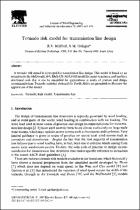JavaScript is disabled for your browser. Some features of this site may not work without it.
- ResearchSpace
- →
- Research Publications/Outputs
- →
- Journal Articles
- →
- View Item
| dc.contributor.author |
Milford, RV

|
en_US |
| dc.contributor.author |
Goliger, Adam M

|
en_US |
| dc.date.accessioned | 2007-02-06T08:59:31Z | en_US |
| dc.date.accessioned | 2007-06-07T10:03:37Z | |
| dc.date.available | 2007-02-06T08:59:31Z | en_US |
| dc.date.available | 2007-06-07T10:03:37Z | |
| dc.date.copyright | en_US | |
| dc.date.issued | 1997-11 | en_US |
| dc.identifier.citation | Milford, RV and Goliger, AM. 1997. Tornado risk model for transmission line design. Journal of Wind Engineering and Industrial Aerodynamics, vol 72, 3 January, pp 469-478 | en_US |
| dc.identifier.issn | 0167-6105 | en_US |
| dc.identifier.uri | http://hdl.handle.net/10204/1488 | en_US |
| dc.identifier.uri | http://hdl.handle.net/10204/1488 | |
| dc.description.abstract | A tornado risk model for transmission line design has been developed. The risk model is based on the McDonald model for point structures and has been developed such that it can be simplified for applications in codes of practice and design recommendations. The model is expanded in terms of damage length of the tornado and the length of transmission line as opposed to the damage area of the tornado which is applicable to point-like structures. The model does not take into account the orientation of transmission line relative to the tornado path, or the point-wise nature of the individual transmission line towers. The design of transmission line structures is typically governed by wind loading, and in some parts of the world, wind loading is in combination with ice loading. The wind load used in most codes of practice and design recommendations for transmission line design have until recently been based almost exclusively on large-scale wind storms, which may include severe storms such as hurricanes and typhoons. Relevant statistics from South Africa are presented to illustrate the application of the model together with tornado risk areas for South Africa. Of interest to note is that in the highest risk areas in South Africa the occurrence of tornadoes per square kilometre is comparable with the lower risk regions in the mid-western USA | en_US |
| dc.format.extent | 436983 bytes | en_US |
| dc.format.mimetype | application/pdf | en_US |
| dc.language.iso | en | en_US |
| dc.publisher | Elsevier Science BV | en_US |
| dc.rights | Copyright: 1997 Elsevier Science BV | en_US |
| dc.source | en_US | |
| dc.subject | Tornado risk model | en_US |
| dc.subject | Severe wind storms | en_US |
| dc.subject | Transmission line structures | en_US |
| dc.subject | Wind loading | en_US |
| dc.subject | Civil engineering | en_US |
| dc.title | Tornado risk model for transmission line design | en_US |
| dc.type | Article | en_US |
| dc.identifier.apacitation | Milford, R., & Goliger, A. M. (1997). Tornado risk model for transmission line design. http://hdl.handle.net/10204/1488 | en_ZA |
| dc.identifier.chicagocitation | Milford, RV, and Adam M Goliger "Tornado risk model for transmission line design." (1997) http://hdl.handle.net/10204/1488 | en_ZA |
| dc.identifier.vancouvercitation | Milford R, Goliger AM. Tornado risk model for transmission line design. 1997; http://hdl.handle.net/10204/1488. | en_ZA |
| dc.identifier.ris | TY - Article AU - Milford, RV AU - Goliger, Adam M AB - A tornado risk model for transmission line design has been developed. The risk model is based on the McDonald model for point structures and has been developed such that it can be simplified for applications in codes of practice and design recommendations. The model is expanded in terms of damage length of the tornado and the length of transmission line as opposed to the damage area of the tornado which is applicable to point-like structures. The model does not take into account the orientation of transmission line relative to the tornado path, or the point-wise nature of the individual transmission line towers. The design of transmission line structures is typically governed by wind loading, and in some parts of the world, wind loading is in combination with ice loading. The wind load used in most codes of practice and design recommendations for transmission line design have until recently been based almost exclusively on large-scale wind storms, which may include severe storms such as hurricanes and typhoons. Relevant statistics from South Africa are presented to illustrate the application of the model together with tornado risk areas for South Africa. Of interest to note is that in the highest risk areas in South Africa the occurrence of tornadoes per square kilometre is comparable with the lower risk regions in the mid-western USA DA - 1997-11 DB - ResearchSpace DP - CSIR KW - Tornado risk model KW - Severe wind storms KW - Transmission line structures KW - Wind loading KW - Civil engineering LK - https://researchspace.csir.co.za PY - 1997 SM - 0167-6105 T1 - Tornado risk model for transmission line design TI - Tornado risk model for transmission line design UR - http://hdl.handle.net/10204/1488 ER - | en_ZA |






